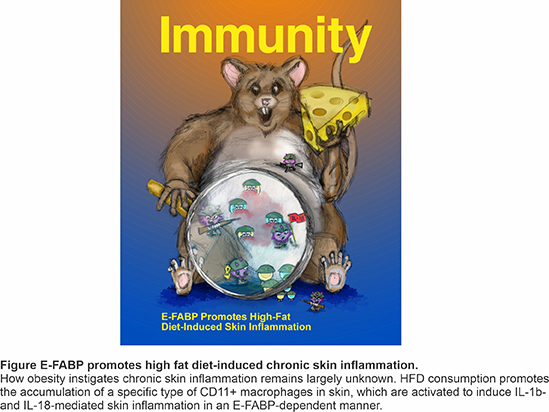
Psoriasis has existed since ancient times as evidence by examination of unearthed Egyptian mummies. It now affects about 7.5 million people in the United States and 125 million people worldwide. Characterized as erythematous plaques with silvery scales, psoriasis remains the most prevalent and intractable immune-mediated chronic inflammatory skin disease, and there is still no curative treatment for psoriasis. Although the development of psoriasis is attributed to a combination of genetic and environmental risk factors (e.g. smoking, stress), the exact causes of psoriasis are not fully understood. Recently, epidemiological studies have identified that obesity is associated with increased severity of psoriasis and poor response to therapy. Loss of body weight or calorie restriction significantly decreases the severity of psoriasis. Given the rising rates of obesity in the United States and worldwide, there is an urgent need to identify new biological mediators which contribute to psoriasis’ pathogenesis and link obesity-associated psoriasis. The goal of this project is to identify such a mediator and to produce mechanistic insights into its role in the pathogenies of psoriasis.
E-FABP (also known as mal1 or FABP5) was first cloned in psoriatic skin tissues and originally named as psoriasis-associated FABP. E-FABP expression is greatly upregulated in human psoriasis and different skin disorders; Besides being abundantly expressed in keratinocytes, E-FABP is also present in immune cells, especially in DCs and T cells and regulates their functions. Moreover, E-FABP expression in CD11c+ cells promotes IFNβ production in response to LPS stimulation and E-FABP expression in CD4+ drives IL-17 production in imiquimod (IMQ)-treated mice (preliminary data Figure 4,5,6). Given the pathogenic role of IFNβ and IL-17 in psoriasis, it is very likely that E-FABP is involved in promoting psoriatic inflammation. More recently, our group demonstrated that E-FABP upregulation in skin CD11c+ cells promotes high fat diet (HFD)-induced chronic skin inflammation. Intriguingly, genetic ablation of E-FABP completely abrogates HFD-induced skin lesions in E-FABP-/- mice, further corroborating a critical role of E-FABP in mediating diet-induced skin inflammation; Our preliminary data further show that E-FABP expression is associated with increased mitochondria oxygen consumption and IFNβ production of in DCs whereas keratinocytes enhances E-FABP expression and increase their metabolic changes (e.g. oxidative phosphorylation (OXPHOS) and glycolytic capacity) in response to IFNβ stimulation, suggesting that E-FABP regulates metabolism and function in both populations; Most importantly, E-FABP deficiency protects mice against various environmental factor-induced skin inflammation (such as NAIR, HFD, and IMQ). Integration of the documented research and our preliminary studies strongly suggests that E-FABP represents a previously-unappreciated mediator linking cellular metabolism and function in immunocytes and keratinocytes, thereby promoting psoriasis development.
Thus, the focus of E-FABP in this project will improve our understanding at the molecular level of how DCs and keratinocytes cooperatively drive psoriasis development. We anticipate that successful completion of this project will establish E-FABP as a new mechanism driving the onset and progression of psoriasis and help us develop an effective psoriasis therapeutic approach via targeting E-FABP.